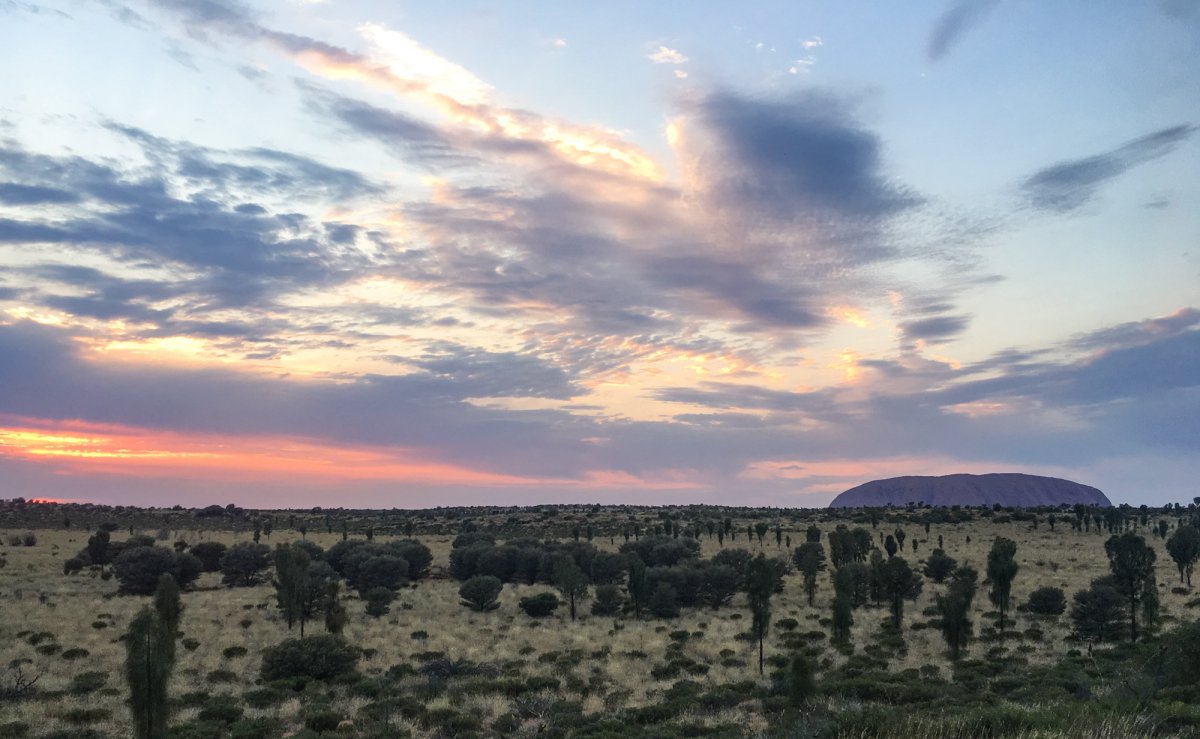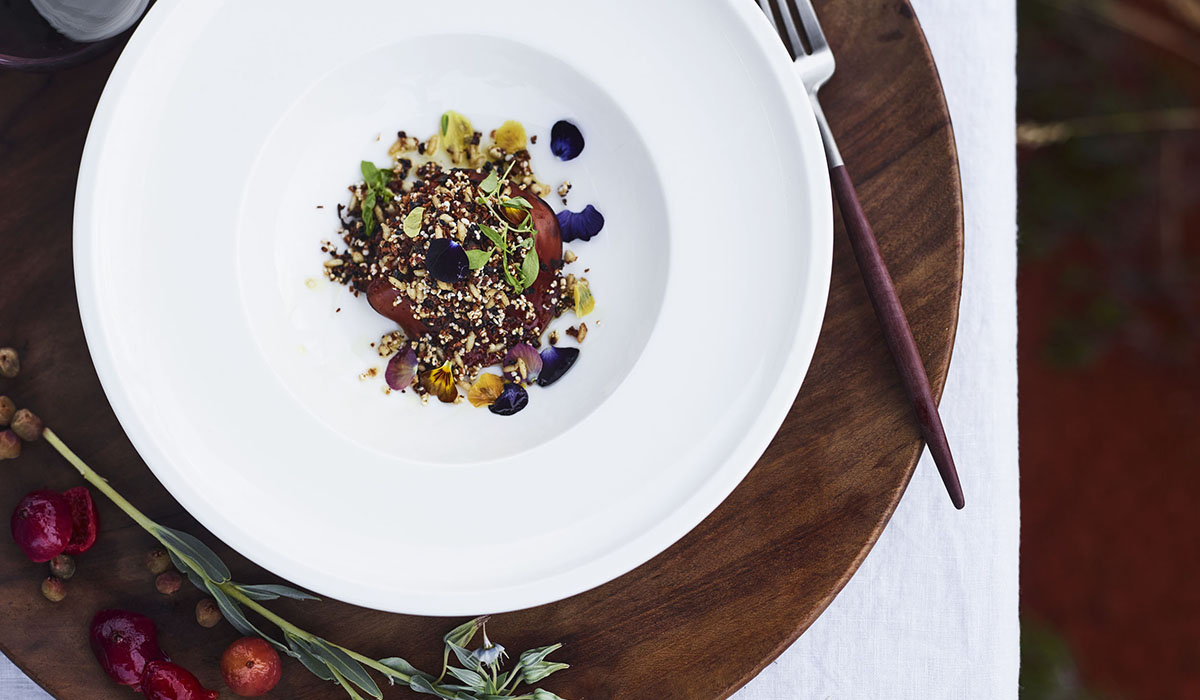One of the best meals in my life to date occurred when I was so jetlagged that I poured a little wine into my lap because my brain and arm had miscalculated the distance between the glass and my face. Thankfully, forkfuls of food got where they needed to go. Despite fatigue and confusion about not only my current time zone but also my hemisphere, my taste buds knew what they knew: This meal was like no other.
After three flights involving about 25 hours of travel, my first trip Down Under brought me to the newly renovated Sails in the Desert at Ayers Rock Resort in Australia’s Northern Territory, which comprises a sizable chunk of the Outback, the continent’s arid central region of 2.5 million square miles and approximately 60,000 remarkably self-reliant people. Flying into it, all I could see were whorls of browns and golds in different shades stretching on forever with barely a speck of green in sight.
The Northern Territory isn’t within easy reach for Americans, but the world’s most beautiful places are often the hardest to get to. I was there to see the sacred Uluru Rock. This part of Australia is known for its natural wonders, not food—a perception that Australian chefs are working hard to change. Yet even if I ate oatmeal the rest of the trip, that one meal on my first night was worth the 10,643 miles I had traversed.



Trading New York City’s 40-degree autumn chill for the Outback’s sweltering 100-degree, late-spring heat appealed to me; I like heat. However, I arrived with a cold acquired during the long trans-Pacific flight. I wanted Australia’s intense sunshine to pound the virus out of me. After all, the Outback wasn’t going to let me nurse a respiratory infection alone in my hotel room. Australia makes Americans’ rugged individualism look like an 18th-century dandy complaining about the wine cellar. No, in Australia you tough it out, even if toughing it out involves five-star dining in a region that grows very little.
Abundant sunshine did help, and got me in the mood for food: canapés of cider-poached crocodile, watermelon cubes with green ants, and kangaroo jerky—all washed down with champagne while watching a desert sky change colors.
Already, I was feeling better. But the best part was yet to come: the dinner I would replay in my mind on an endless loop back home in the States.
Inside Sails’ simple but posh dining room, we sat down to an Oh-my-God-I-can’t-believe-how-amazing-this-is meal prepared by internationally renowned chef Vanessa Grace. After a small appetizer of tomato and basil (a splash of familiarity before plates of the peculiar), the second course was placed before me: pressed wallaby with fermented quandong, a yogurt sauce, and pomegranate (pictured in the top image).
First: I didn’t know what a wallaby looked like, so my dinner companion held up her phone to show me a selfie of her smiling beside a cuddly, doe-eyed one while I chewed on its relative’s delicious, tender flesh. The creature looked like a mating mishap between a kangaroo and a rat.
Second: How and why wallabies are so tasty, I don’t know (they’re herbivores). I am not much of a carnivore let alone an adventurous eater, yet I wolfed down that cooked wallaby like a Five Guys double cheeseburger on a Friday night. All I could repeat to my dinner companions were trite platitudes like “This is so delicious!” I was too tired to find the right adjectives but the wallaby was succulent and not salty, like a meat lollipop. It tasted incredibly fresh, and I wondered while eating it how recently the animal had been roaming the earth, because it was so surprisingly good that surely the hand of God existed in each bite.
To cook this well in the middle of the desert was no small feat; twice a week, food and supplies are trucked in by three-fully loaded rigs driving approximately one thousand rather desolate but spectacular miles each way along the Stuart Highway from Adelaide. Fresh produce imported first to the coastal regions, as well as international specialty foods, such as Serguva cavier, are brought in this way. More supplies are also trucked in 275 miles from “nearby” Alice Springs.
Considering this, it felt selfish to want more wallaby but I wanted more wallaby. I had traveled 10,000 miles. I would have eaten wallaby for dessert, but the third course was on its way: roasted cauliflower, followed by a sexy-titled dessert called “Textures of Chocolate,” as well as rosella and lychee gateaux, capped by an Australian cheese selection in case all the crocodile, kangaroo, and wallaby hadn’t filled me up.
Enjoying wallaby surprised me. So did eating green ants.
The man who introduced me to the area’s green ants is Mark Olive, another internationally renowned chef acclaimed for his indigenous Australian cuisine and popular television cooking shows. Mark’s mission is to convey that Australian food isn’t just barbecue and Fosters beer (which all Australians told me that no one drinks), but that there’s tremendous bounty and culinary creativity in the heart of the world’s oldest continent.
His advocacy is working: green ants are infused in gin, added to award-winning goat cheese, and are popping up on platters and tables everywhere around Australia.
“Indigenous people have been eating green ants for a long time,” Olive said. He suggested I sprinkle some onto my poached salmon; it was like squeezing a splash of lemon juice on to seafood. “Their rear ends are acidic, giving food a citrus finish,” he explained.
The little buggers aren’t cheap: green ants go for $750 AUD, or about $567 USD, per kilogram. I probably—thoughtlessly—sprinkled at least $100 worth of ants onto my lunch with a single flick of the wrist. I went back for a second helping, wondering if that citrus taste might help with my cold.
Mark also encouraged me to nibble on various plates of native bush herbs, nuts and seeds such as wattleseed and lemon myrtle, and he pointed out which ones were high in vitamin C to help with my sneezing and sniffling, particularly quandong seeds, which contains twice as much vitamin C as an orange, and which I pounded like they were green ants.
“We have this problem with eating our coat of arms here,” he said. “We import foods from all around the world when we have so much here. We just really have to embrace it more.”
I told him I ate pressed wallaby for dinner the night before, and that it was downright luxurious. He looked pleased. “The best part is their rump.”



Leaving Sails after three nights was hard, but after breakfast, it was time to head to Alice Springs, known as the capital of the Outback, which feels more like a national wildlife park with buildings and retail chains than a city. But before Alice Springs, more opportunities to nosh on the coat of arms available at the breakfast buffet: omelets with diced kangaroo if I needed more protein (I didn’t). Kangaroo is the nation’s venison; the creatures hop across streets causing drivers to brake suddenly, graze on landscaping, and end up on plates. Roasted roo can be found on anything in Australia, prepared high-end or as takeout, from a vindaloo curry to pizza to a burger bun.
What also finds its way onto a burger bun in the Outback is camel, which I ate about six hours after riding one (not the same animal).
Not indigenous to Australia and obviously not on the coat of arms are the camels Australia imported from Afghanistan and the Canary Islands during colonization because of their efficiency in moving supplies across an almost endless central desert. And if it moves, well, then you can and should eat it, as we discovered at the Glen Helen Homestead Lodge, a hybrid motel, roadside café, bistro restaurant, gas station and general store 82 miles west of Alice Springs on the main road—Namatjira Drive—which takes you into the stunning and stark West MacDonnell National Park.
Burgers were available in beef, kangaroo or camel at the general store counter. Nearby, mismatched seating joined an old piano in the corner. We were on a schedule, so lunch would be fast food scarfed down while seated on a threadbare sofa. Since I had participated in a sunrise camel ride that morning, I decided to see what camels tasted like when they weren’t carrying me across the bush.
Australia had lowered my inhibitions.
Dozens of wasps circled overhead while we batted away flies that seemed to multiply in mid-air. Australia has tons of bugs (Mark warned me about all the different spiders that get into people’s laundry in Sydney), and I have an allergy to wasps and hornets, so I chewed my camel quickly, and kept a watchful eye on my purse, which contained my Epi-Pen.
Let’s just say lunch was no pressed wallaby—but what could ever follow that dish? The camel was tough, and reminded me of school cafeteria mystery meat patties. But I wasn’t going to blame the camel. You get what you pay for when it’s a $6 burger from a roadside counter. For all I know, the beef and kangaroo burgers tasted identical.
Chewing mint gum to get the taste of sinewy camel out of my mouth didn’t deter me (it took two pieces). I was in love. Australia had won me over. I’m someone who never could stomach the texture of steak (still can’t), and only eats bland chicken if pulled, spiced, and served in a taco (wallaby tacos—now there’s an opportunity!).
Yet, the land that gave us the Brothers Hemsworth, Dame Edna, Bondi Beach, Uggs, Vegemite, adorable and delicious marsupials, not to mention a funky slang outsiders struggle to follow (“bogan,” “crikey,” “flat whites” and my personal favorite “I’m not here to f&*k spiders,” translation: “Let’s get the job done”), as well as the oldest rocks on the planet had wooed me into a swoon. Consider me wined, dined, and hungry for more.
Feature image courtesy of Voyages Indigenous Tourism Australia.







